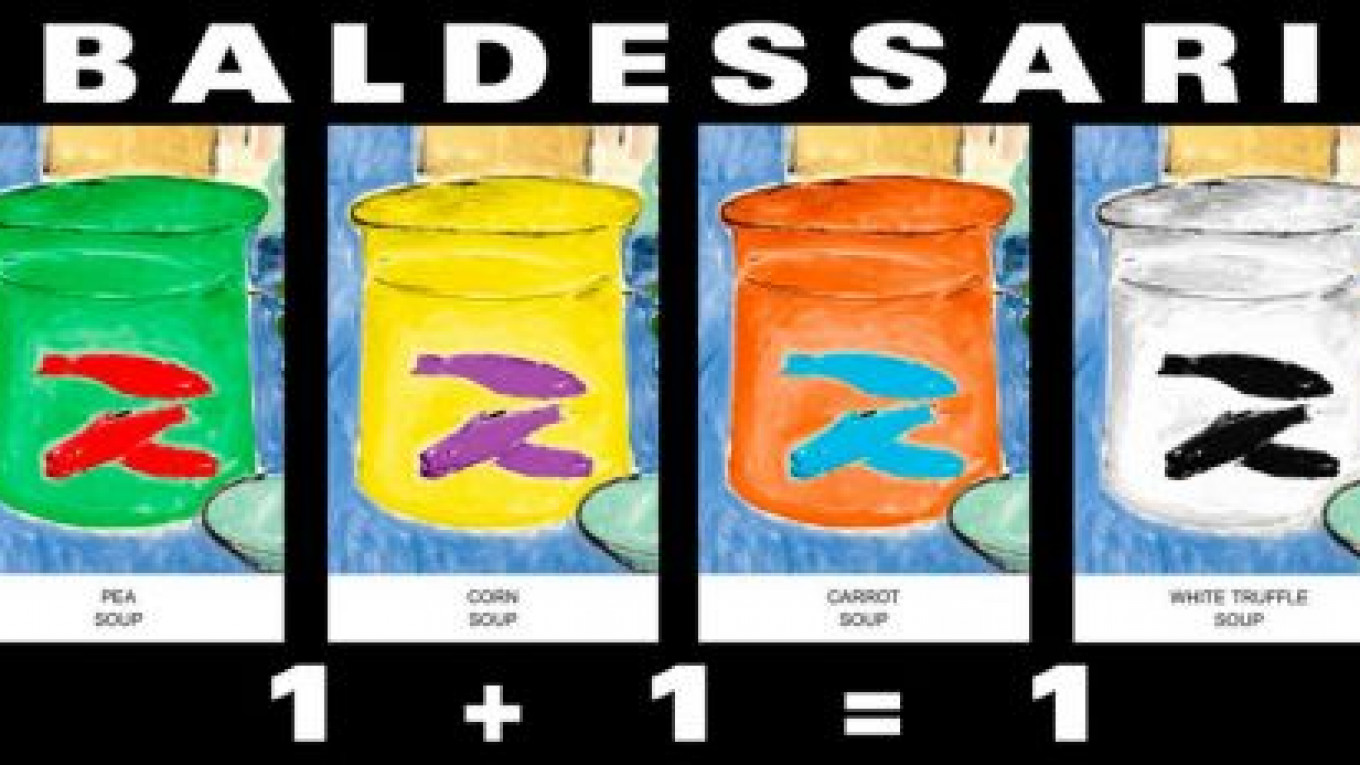John Baldessari's art has attracted its fair share of controversy in the past: From his sweeping declaration that he would "make no more boring art" to his symbolic cremation of a decade's worth of old work, the artist has a penchant for gestures that ask the viewer to consider the concept: What is art? Baldessari's Moscow exhibit, "1+1=1," which opened at the Garage Center for Contemporary Culture on Friday as part of the 5th Moscow Biennale of Contemporary Art, not only flouts the laws of mathematics with its title but also continues to contemplate the limits of art.
"I've always avoided the term conceptualist; I've always preferred to be called just an artist," said Baldessari during a discussion with Ilya Kabakov at the Central House of Artists on Wednesday. Baldessari denounced conceptualism as "a term invented by journalists to try to describe a commonality," dismissing a buzzword that is worn as a mark of honor by many of the most prominent Russian artists, among them Ilya Kabakov.
Despite his rejection of the conceptualist label, Baldessari's description of how he arrived at his signature style seems wholly conceptualist. Baldessari explained how the art world had viewed his early works, saying "they looked at it and said 'well, it looks like something my kid could paint.' So I thought, well, what if I could give them what they want?" As a result of this epiphany, Baldessari turned to making paintings that commented upon themselves, self-explanatory works that instruct the viewer in how to view them properly.
‘Sometimes I worry that I’m not making art, I’m making trinkets for rich people.’
John Baldessari
Indeed, Baldessari's tongue-in-cheek satire of the arts world and his emphasis on his individualism seems to clearly set him apart from the contemporary Russian arts world, which is dominated by prominent galleries and arts groups, making it a difficult landscape for young, nonconformist artists. Baldessari commented on the difficulties of working as an artist in a society dominated by the gallery system, saying that "sometimes I worry at night that I'm not making art, I'm making trinkets for rich people."
This contrast was clearly visible in Baldessari's discussion with Ilya Kabakov. Kabakov, who is one of the most well-known living Russian artists, has had great success abroad and has exhibited works in the same circles as Baldessari. The two have exhibited together at least three times in the past and have met on several occasions. However, the two clashed repeatedly both on the role of individualism in the arts world and the function of arts education.
Kabakov was quick to note Baldessari's use of "I" in describing his work, stating that this individualism was characteristic of an "immature" artist and that a developed artist would use the term "we," indicating his colleagues and the arts world as a whole. Baldessari dismissed the notion of an arts community, focusing on an individual approach to art, absent labels and movements, and put this down in part to his origins in California, a place largely devoid of the art history widely visible in Europe.
Another point of contention between the two artists was the role of education in art. Baldessari flatly stated that "I've always thought that art cannot be taught," though his many years of experience as an arts teacher in schools and universities seems to make this a somewhat contradictory statement. Kabakov strongly disagreed, emphasizing the role of arts schools in giving fundamental tools to young artists and teaching them how to view the world. Though the conversation between the two respected artists remained cordial at all times, they appeared to disagree on nearly every point.
Baldessari's uniquely individualist style was reflected in his exhibit "1+1=1." In his latest batch of works, Baldessari combines iconic works and styles from pairs of different artist to create new, wholly original works, leading to the title "1+1=1." The works are divided into sections such as Double Play, Double Bill, Double Vision and Double Feature, which loosely address the themes of the works.
While many of the works are labeled with names of artists whose work has presumably been incorporated, most viewers will frequently be hard-pressed to identify which works have been synthesized in each of Baldessari's creations. While some paintings seem reminiscent of Andy Warhol, Jasper Johns and Jackson Pollock, the precise pairings remain mysterious, and the works on display are on occasion more interesting than the ones they draw inspiration from. Baldessari has truly made 1+1=1.
John Baldessari's exhibit "1+1=1" will be on display until Nov. 24 at the Garage Center for Contemporary Culture, 9/45 Ulitsa Krymsky Val, Metro Oktyabrskaya.
Contact the author at [email protected]
A Message from The Moscow Times:
Dear readers,
We are facing unprecedented challenges. Russia's Prosecutor General's Office has designated The Moscow Times as an "undesirable" organization, criminalizing our work and putting our staff at risk of prosecution. This follows our earlier unjust labeling as a "foreign agent."
These actions are direct attempts to silence independent journalism in Russia. The authorities claim our work "discredits the decisions of the Russian leadership." We see things differently: we strive to provide accurate, unbiased reporting on Russia.
We, the journalists of The Moscow Times, refuse to be silenced. But to continue our work, we need your help.
Your support, no matter how small, makes a world of difference. If you can, please support us monthly starting from just $2. It's quick to set up, and every contribution makes a significant impact.
By supporting The Moscow Times, you're defending open, independent journalism in the face of repression. Thank you for standing with us.
Remind me later.






